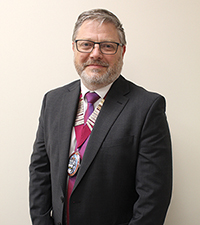Meet BINDT’s new President
20/03/2025
Jason Taylor, Technical Manager Industries and Environment with SGS, is BINDT’s President for the next two years. To give readers the opportunity to find out what his plans are for his term of office, NDT News posed a few questions to the new President… | ||
| Jason Taylor |
Tell us a little about yourself and your background in NDT.
My non-destructive testing (NDT) career has, to say the least, been varied. Over the last 35 plus years, I have worked for very small NDT companies, large companies and, with my current employer, arguably the largest testing, inspection and certification company in the world. My areas of hands-on work have included structural steelwork, ships surveys, aerospace, petrochemical, pipework/vessel manufacture, nuclear, in-service inspections, in factories, on-site and offshore.
I started as an Assistant Radiographer so, for some reason, I probably think of myself primarily as a radiographer, although I have probably spent more time in the disciplines that I acquired as I went along. I now hold PCN
Level 3 in magnetic particle inspection (MPI), dye penetrant inspection (DPI), ultrasonic testing (UT) and radiographic testing (RT) as well as ASNT Level III in magnetic particle testing (MT), penetrant testing (PT), visual testing (VT), RT and UT. I have always maintained my Level 2s; in addition to making it marginally easier to maintain my Level 3s, it also allows me to put a set of overalls on and actually do the job.
As the Technical Manager of SGS’s UK Industrial Division, NDT only forms part of my day-to-day activities, but I often support both clients and SGS in other countries with advice on best practice and auditing.
As the new President of BINDT, what do you see as the biggest challenges for the Institute?
What are your priorities as the new President?
My main goal is to ensure the Institute is not only representing the best interests of its stakeholders but is seen to be doing so. We have a lot of good people working very hard towards creating and maintaining an Institute that is fit for purpose and it is important that people see that.
I want to see the IT development that will allow technicians to upload continuing professional development (CPD) records and have them verified and approved, giving a real-time dashboard view of their progress to recertification. Automation of processes with oversight by the Technical NDT Team the Institute now has in place should streamline the whole process and make technicians be and feel in control of the process.
How do you see the Institute’s role developing in the changing NDT world?
The Institute is pushing hard with representation on British Standards Institution (BSI) and International Organization for Standardization (ISO) committees to try and ensure that future standards make sense and actually work in the real world. By working with other institutions such as the Safety Assessment Federation (SAFed), the Engineering Equipment and Materials Users Association (EEMUA), Harwell Offshore Inspection Service (HOIS), the Institution of Civil Engineering (ICE), the UK Research Centre in Non-Destructive Evaluation (RCNDE), the Health and Safety Executive (HSE) and the Environment Agency, amongst others, we can ensure that our people’s best interests are represented.
How has your professional career helped you prepare for this latest challenge?
From the start, as an NDT Technician you develop a thick skin pretty quickly. Your whole job often entails telling a skilled craftsperson that they have not done their job properly or an asset owner that they cannot use the equipment they need to operate.
As the President of BINDT, I will be a focal point for people who want to complain, and I welcome that. If you have constructive criticism of what the Institute has or has not done, please let me know. I will listen. I may or may not agree, but I will take any input forward and use it to shape our future.
This is your Institute, representing you.